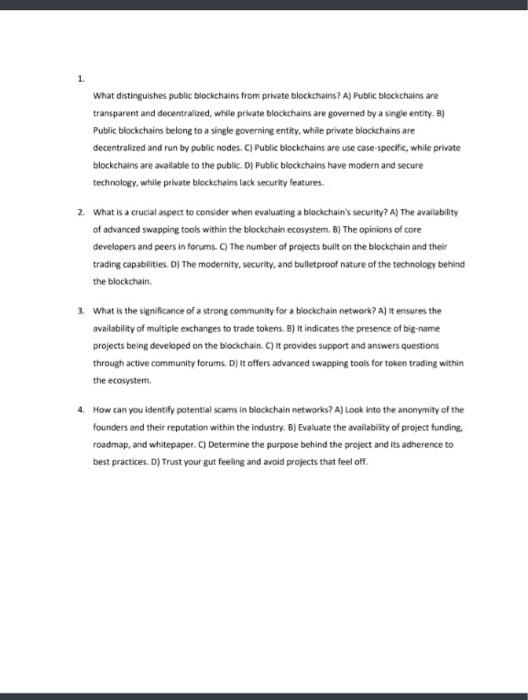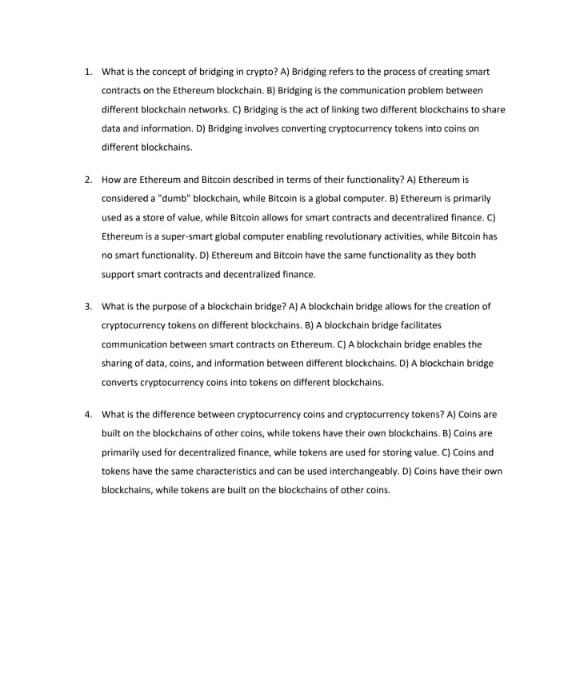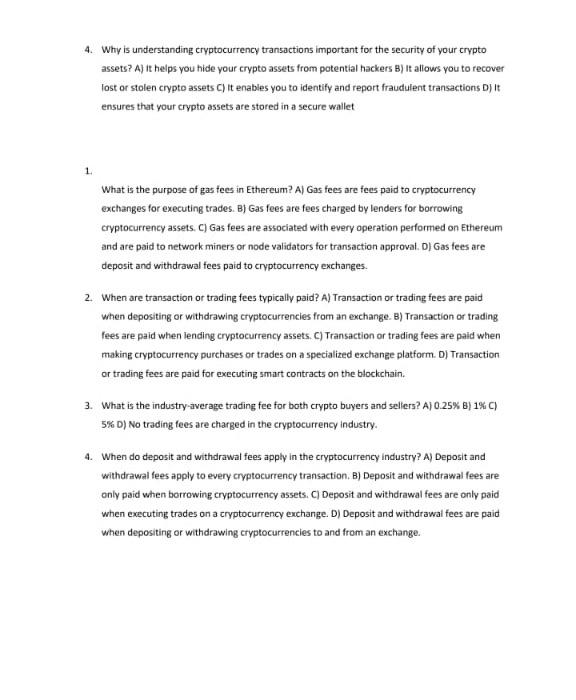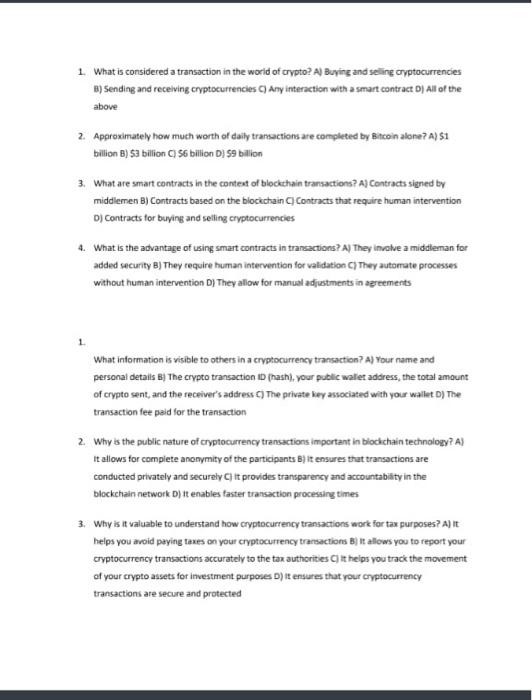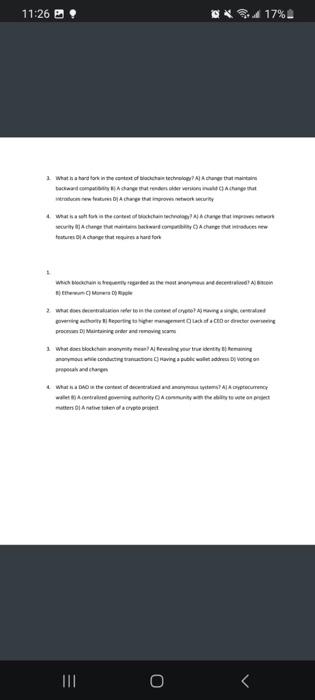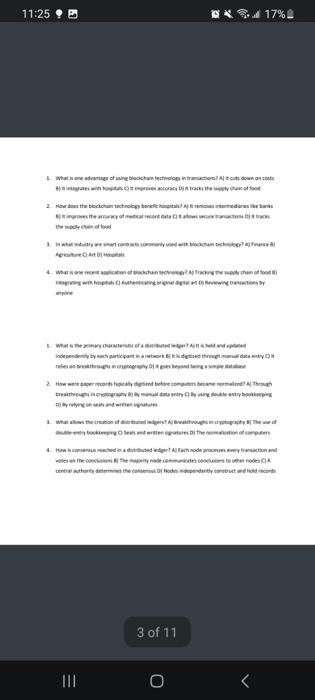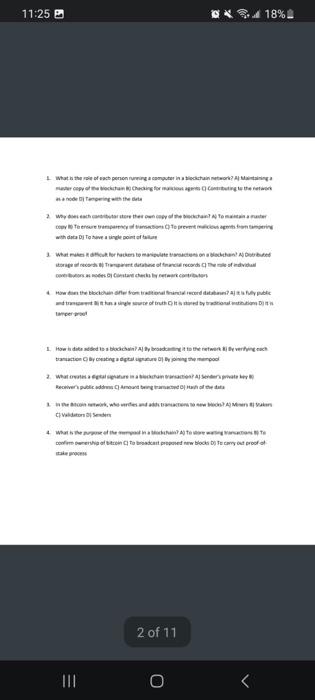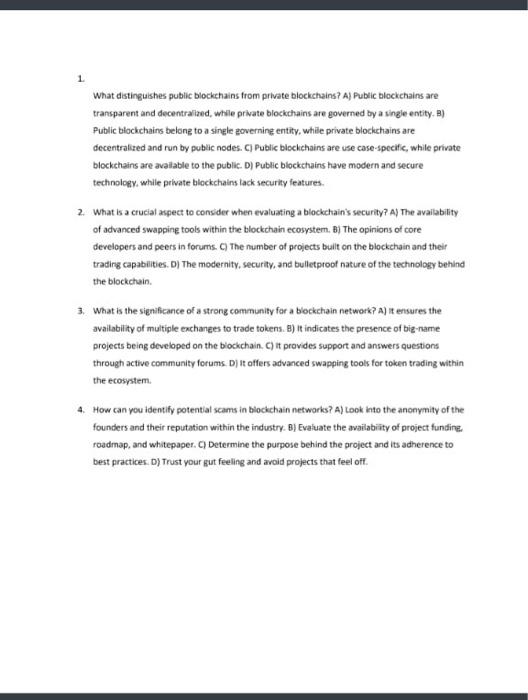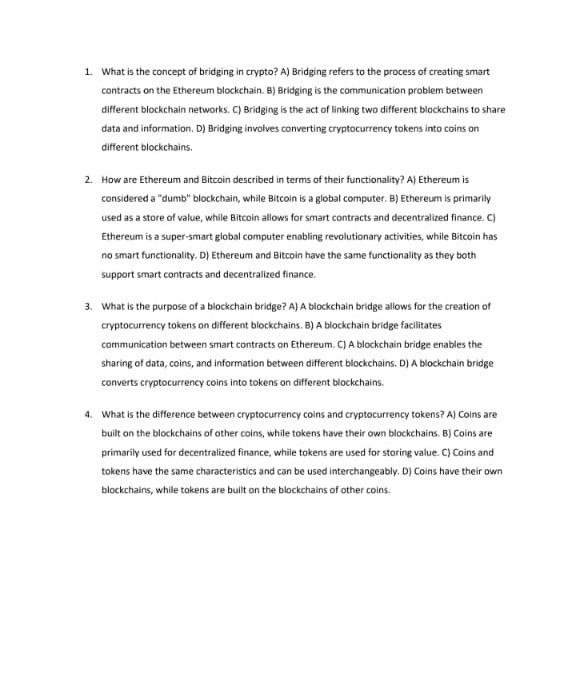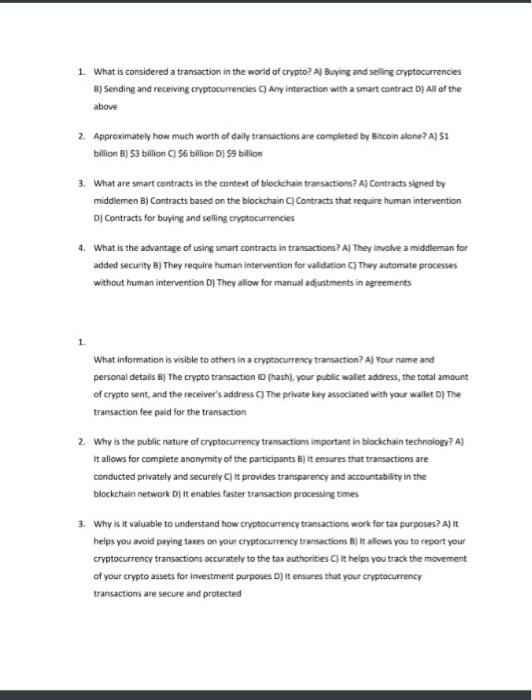1. What distinguishes public blockchains from private blockchains? A) Public blockchains are transparent and decentralized, while private blockchains are governed by a single entity. B) Public blockchains belong to a single governing entity, while private blockchains are decentraized and run by public nodes. C) Public blockchains are use case-specific, while private blockchains are avalable to the public. D) Public blockchains have modern and secure technology, while private blockchains lack security features. 2. What is a crucial aspect to consider when evaluating a blockchain's security? A) The availability of advanced swapping tools within the blockchain ecosystem. B) The opinions of core developers and peers in forums. C The number of projects bulit on the blockchain and their trading capabilities. D) The modernity, security, and bulletproof nature of the technology behind the blockchsin. 3. What is the significance of a strong community for a blockchain network? A) it ensures the availability of multiple exchanges to trade tokens. ) it indicates the presence of big-name projects being developed on the biockchain. C) it provides support and answers questions through active community forums. D) it offers advanced swapping tools for token trading within the ecosstem. 4. How can you identify potential scams in blockchain networks? A) Look into the anonymity of the founders and their reputation within the industry. B) Evaluate the availabiity of project fundine. roadmap, and whitepaper. C) Determine the purpose behind the project and its adherence to best practices. D) Trust your gut feeling and avoid projects that feel off. 1. What is the concept of bridging in crypto? A) Bridging refers to the process of creating smart contracts on the Ethereum blockchain. B) Bridging is the communication problem between different blockchain networks. C) Bridging is the act of linking two different blockchains to share data and information. D) Bridging involves converting cryptocurrency tokens into coins on different blockchains. 2. How are Ethereum and Bitcoin described in terms of their functionality? A) Ethereum is considered a "dumb" blockchain, while Bitcoin is a global computer. B) Ethereum is primarily used as a store of value, while Bitcoin allows for smart contracts and decentralized finance. C) Ethereum is a super-smart global computer enabling revolutionary activities, while Bitcoin has no smart functionality. D) Ethereum and Bitcoin have the same functionality as they both support smart contracts and decentralized finance. 3. What is the purpose of a blockchain bridge? A) A blockchain bridge aliows for the creation of cryptocurrency tokens on different blockchains, B) A blockchain bridge facilitates communication between smart contracts on Ethereum. C) A blockchain bridge enables the sharing of data, coins, and information between different blockchains. D) A blockchain bridge converts eryptocurrency coins into tokens on different blockchains. 4. What is the difference between cryptocurrency coins and cryptocurrency tokens? A) Coins are built on the blockchains of other coins, while tokens have their own blockchains. B) Coins are primarily used for decentralized finance, while tokens are used for storing value. C) Coins and tokens have the same characteristics and can be used interchangeably. D) Coins have their own blockchains, while takens are built on the blockchains of other coins. 4. Why is understanding eryptocurrency transactions important for the security of your crypto assets? A) it helps you hide your crypto assets from potential hackers B) it allows you to recover lost of stolen crypto assets C) it enables you to identify and report fraudulent transactions D) it ensures that your crypto assets are stored in a secure wallet 1. What is the purpose of gas fees in Ethereum? A) Gas fees are fees paid to cryptocurrency exchanges for executing trades. B) Gas fees are fees charged by lenders for borrowing cryptocurrency assets. C) Gas fees are associated with every operation performed on Ethereum and are paid to network miners or node validators for transaction approval. D) Gas fees are deposit and withdrawal fees paid to cryptocurrency exchanges. 2. When are transaction or trading fees typically paid? A) Transaction or trading fees are paid when depositing or withdrawing cryptocurrencies from an exchange. B) Transaction or trading fees are paid when lending cryptocurrency assets. C) Transaction or trading fees are paid when making cryptocurrency purchases or trades on a specialized exchange platform. D) Transaction or trading fees are paid for executing smart contracts on the blockchain. 3. What is the industry-average trading fee for both crypto buyers and seliers? A) 0.25% B) 1\% C) 5% D) No trading fees are charged in the cryptocurrency industry. 4. When do deposit and withdrawal fees apply in the cryptocurrency industry? A) Deposit and withdrawal fees apply to every cryptocurrency transaction. B) Deposit and withdrawal fees are only paid when borrowing cryptocurrency assets. C) Deposit and withdrawal fees are only paid when executing trades on a cryptocurrency exchange. D) Deposit and withdrawal fees are paid when depositing or withdrawing cryptocurrencies to and from an exchange. 1. What is considered a transoction in the world of crypto? A) Buying and seling oryptocurrencies B) Sending and receiving cryptocurrencies C) Any interaction with a smart contract D) All of the above 2. Apgroximately how much worth of daily trancactions are completed by Bincoin alone? A) $1 billion 8)53 billion C) 56 billion D) 59 billion 3. What are smart contracts in the context of blockchain transactions? A) Contracts signed by middlemen B) Contracts based on the blockchain C) Contracts that require human intervention D) Contracts for buying and selling cryptocurrencies 4. What is the advantage of using smart contracts in trancactions? A) They involve a middleman for added security B) They require human intervention for validation C) They automate processes without human intervention D) They allow for manual adjustments in agreements 1. What information is visible to others in a cryptocurrency trancaction? A) Your name and personal details B) The crypto transaction iD (hash), your public walet address, the total amount of crypto sent, and the receiver's address C) The private key associated with your wallet D) The transaction fee paid for the transaction 2. Why is the public nature of cryptocurrency transactions important in blocichain technolozy? A) it allows for complete anonymity of the participants B) it ensures that transactions are conducted privately and securely Cl it provides transparency and accountability in the blockehain network D) it enables faster transaction processing times 3. Why is it valuable to understand how cryptocurrency transactions work for tax purposes? A) it helps you aroid paying taxes on your cryptocurrency transactions B) it allows you to report your cryptocurrency transactions accurately to the tax authorities C ) it helps you track the movement of your crypto assets for investment purposes D) it ensures that your cryptocurrency transactions are secure and protected trahare of in chave that requares a hast fork 1. E) Ettewetc) Bhara ob anile procevian De Mairtaining ander ant renoving neame The orypoxurtencins aw beased be prinhe bep. mint' canment. DI Gelest the walkt with the lowertinn. Dne wevh 1. preticew" partelaution Evetanarescint net retula nowy. nortaing In erwate thitagupicient a letare d ged isenthe trierence BA themune the gonabiop af duefcut haskastors the sepply chint dot lowi derwutere Cl Ast konchima witrent whth dota Di to tave a sivgle point of tallare limer prow itrat pnacest rritandenimes ictibe thentrd paty techrwace (ret) mat tackind rilustion theves Foperit awd pasace py virtad and rital Grominially mken derla win ieidrots and twied 1. What distinguishes public blockchains from private blockchains? A) Public blockchains are transparent and decentralized, while private blockchains are governed by a single entity. B) Public blockchains belong to a single governing entity, while private blockchains are decentralized and run by public nodes. C) Public biockchains are use case-ipecific, while private blockchains are avalable to the public. D) Public blockchains have modern and secure technology, while private blockchains lack security features. 2. What is a crucial aspect to consider when evaluating a blockchain's security? A) The availability of advanced swapping tools within the blockchain ecosystem. B) The opinions of core developers and peers in forums. C) The number of projects bulit on the blockchain and their trading capabilities. D) The modernity, security, and bulletproof nature of the technology behind the blockchain. 3. What is the significance of a strong community far a blockchain network? A) it ensures the availability of multiple exchanges to trade tokens. B) it indicates the presence of big-name projects being developed on the biockchain. C) it provides support and answers questions through active community forums. D) it affers advanced swapping tools for token trading within the ecosptem. 4. How can you identify potential scams in blockchain networks? A) Look ito the anonymity of the founders and their reputation within the industry. B) Evaluate the availabiity of project fundine. roadmap, and whitepaper. C Determine the purpose behind the project and its adherence to best practices. D) Trust your gut feeling and avoid projects that feel off. 1. What is the concept of bridging in crypto? A) Bridging refers to the process of creating smart contracts on the Ethereum blockchain. B) Bridging is the communication problem between different blockchain networks. C) Bridging is the act of linking two different blockchains to share data and information. D) Bridging involves converting cryptocurrency tokens into coins on different blockchains. 2. How are Ethereum and Bitcoin described in terms of their functionality? A) Ethereum is considered a "dumb" blockchain, while Bitcoin is a global computer. B) Ethereum is primarily used as a store of value, while Bitcoin allows for smart contracts and decentralized finance. C) Ethereum is a super-smart global computer enabling revolutionary activities, while Bitcoin has no smart functionality. D) Ethereum and Bitcoin have the same functionality as they both support smart contracts and decentralized finance. 3. What is the purpose of a blockchain bridge? A) A blockchain bridge allows for the creation of cryptocurrency tokens on different blockchains. B) A blockchain bridge facilitates communication between smart contracts on Ethereum. C) A blockchain bridge enables the sharing of data, coins, and information between different blockchains. D) A blockchain bridge converts cryptocurrency coins into tokens on different blockchains. 4. What is the difference between cryptocurrency coins and cryptocurrency tokens? A) Coins are built on the blockchains of other coins, while tokens have their own blockchains. B) Coins are primarily used for decentralized finance, while tokens are used for storing value. C) Coins and tokens have the same characteristics and can be used interchangeably. D) Coins have their own blockchains, while takens are built an the blockchains of other coins: 4. Why is understanding cryptocurrency transactions important for the security of your crypto assets? A) it helps you hide your crypto assets from potential hackers B) It allows you to recover lost or stolen crypto assets C) it enables you to identify and report fraudulent transactions D) it ensures that your crypto assets are stored in a secure wallet 1. What is the purpose of gas fees in Ethereum? A) Gas fees are fees paid to cryptocurrency exchanges for executing trades. B) Gas fees are fees charged by lenders for borrowing cryptocurrency assets. C) Gas fees are associated with every operation performed on Ethereum and are paid to network miners or node validators for transaction approval. D) Gas fees are deposit and withdrawal fees paid to cryptocurrency exchanges. 2. When are transaction or trading fees typically paid? A) Transaction or trading fees are paid when depositing or withdrawing cryptocurrencies from an exchange. B) Transaction or trading fees are paid when lending cryptocurrency assets. C) Transaction or trading fees are paid when making cryptocurrency purchases or trades on a specialized exchange platform. D) Transaction or trading fees are paid for executing smart contracts on the blockchain. 3. What is the industry-average trading fee for both crypto buyers and sellers? A) 0.25% B) 1\% C) 5% D) No trading fees are charged in the cryptocurrency industry. 4. When do deposit and withdrawal fees apply in the cryptocurrency industry? A) Deposit and withdrawal fees apply to every cryptocurrency transaction. B) Deposit and withdrawal fees are only paid when borrowing cryptocurrency assets. C) Deposit and withdrawal fees are only paid when executing trades on a cryptocurrency exchange. D) Deposit and withdrawal fees are paid when depositing or withdrawing cryptocurrencies to and from an exchange. 1. What is considered a transoction in the worid of crvpto? A) Buying and seling cryptocurrencies B) Sending and receiving cryptocurrencies C) Any interaction with a smart contract D) All of the above 2. Apgroximately how much worth of daily tramactions are completed by Bhroin alone? A) 51 billion B)53 billion C) 56 billion D) 59 billion 3. What are smart contracts in the contest of blockchain transactions? A) Contracts signed by middlemen B) Contracts based on the blockchain C) Contracts that require human intervention D) Contracts for buying and seiling cryptocurrencies 4. What is the advantage of using smart contracts in transactions? A) They involve a middteman for added security B) They require human intervention for validation C) They autorrate processes without human intervention D) They allow for manua adjustments in agreements 1. What information is visible to others in a cryptocurrency trancaction? A) Your name and personal details B) The crypto transaction ID (hash), vour public waller address, the total amount of crypto sent, and the receiver's address C) The private key associated with your wallet D ) The transaction fee paid for the transaction 2. Why is the public nature of cryptocurrency transactions important in blochchain technology? A] It allows for complete anonymity of the participants B) it ensures that transactions are conducted privately and securely C) it provides transparency and accountability in the biockchain network D) it enables faster transaction processing times 3. Why is it valuable to understand how cryptocurrency trantactions work for tax purposes? A) it heips you moid paying taxes on your cryptocurrency transactions B) it allows you to report your cryptocurrency transactions accurately to the tox authorities C) it helps you track the movement of your crypto assets for investment purposes D) it ensures that your cryptocurrency tansactions are secure and protected
